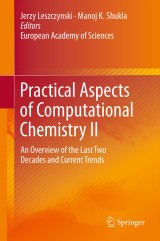Details

Practical Aspects of Computational Chemistry II
An Overview of the Last Two Decades and Current Trends|
213,99 € |
|
| Verlag: | Springer |
| Format: | |
| Veröffentl.: | 09.07.2012 |
| ISBN/EAN: | 9789400709232 |
| Sprache: | englisch |
| Anzahl Seiten: | 541 |
Dieses eBook enthält ein Wasserzeichen.
Beschreibungen
<p><i>Practical Aspects of Computational Chemistry II: An Overview of the Last Two Decades and Current Trends </i>gathers the discussion of advances made within the last 20 years by well-known experts in the area of theoretical and computational chemistry and physics. The title reflects the celebration of the twentieth anniversary of the “Conference on Current Trends in Computational Chemistry (CCTCC)” to success of which all authors contributed.<br></p><p>Starting with the recent development of modeling of solvation effect using the Polarizable Continuum Model (PCM) at the Coupled-Cluster level and the effects of extreme pressure on the molecular properties within the PCM framework, this volume focuses on the association/dissociation of ion pairs in binary solvent mixtures, application of graph theory to determine the all possible structures and temperature-dependent distribution of water cluster, generalized-ensemble algorithms for the complex molecular simulation, QM/MD based investigation of formation of different nanostructures under nonequilibrium conditions, quantum mechanical study of chemical reactivity of carbon nanotube, covalent functionalization of single walled-carbon nanotube, designing of functional materials, importance of long-range dispersion interaction to study nanomaterials, recent advances in QSPR/QSAR analysis of nitrocompounds, prediction of physico-chemical properties of energetic materials, electronic structure and properties of 3d transition metal dimers, the s-bond activation reactions by transition metal complexes, theoretical modeling of environmental mercury depletion reaction, organolithium chemistry and computational modeling of low-energy electron induced DNA damage.<br><i>Practical Aspects of Computational Chemistry II: An Overview of the Last Two Decades and Current Trends </i>is aimed at theoretical and computational chemists, physical chemists, materials scientists, and particularly those who are eager to apply computational chemistry methods to problems of chemical and physical importance. This book provides valuable information to undergraduate, graduate, and PhD students as well as to established researchers.</p></p><p><i>Practical Aspects of Computational Chemistry II: An Overview of the Last Two Decades and Current Trends </i>is aimed at theoretical and computational chemists, physical chemists, materials scientists, and particularly those who are eager to apply computational chemistry methods to problems of chemical and physical importance. This book provides valuable information to undergraduate, graduate, and PhD students as well as to established researchers.</p>
On two recent developments in the description of molecular properties in solution by using the Polarizable Continuum Model (PCM): the coupled-cluster theory, and the molecules at extreme pressures.- The distribution of internal distances for ionic pairs in solvents of various polarity.- Digraph in Chemistry: All Possible Structures and Temperature-dependent Distribution of Water Cluster.- "Generalized-Ensemble Algorithms for Simulations of Complex Molecular Systems".- "Generalized-Ensemble Algorithms for Simulations of Complex Molecular Systems".- Modelling of Chemical Reactivity of Carbon Nanotubes: A Review.- Advancing Understanding and Design of Functional Materials through Theoretical and Computational Chemical Physics.- New Advances in QSPR/QSAR Analysis of Nitrocompounds: Solubility, Lipophilicity and Toxicity.- Progress in Predictions of Environmentally Important Physico-Chemical Properties of Energetic Materials: Applications of Quantum-Chemical Calculations.- State-of-the-art calculations of the 3d transition-metal dimers: Mn2 and Sc2.- Theoretical Study of -Bond Activation Reactions and Catalytic Reactions by Transition Metal Complexes .- Application of Quantum-Chemical Techniques to Model Environmental Mercury Depletion Reactions.- Computational Perspectives on Organolithium Carbenoids.- Potential Path of DNA Damage: Electron Attachment Induced DNA Single Strand Breaks.
Practical Aspects of Computational Chemistry II: An Overview of the Last Two Decades and Current Trends gathers the discussion of advances made within the last 20 years by well-known experts in the area of theoretical and computational chemistry and physics. The title reflects the celebration of the twentieth anniversary of the “Conference on Current Trends in Computational Chemistry (CCTCC)” to success of which all authors contributed. Starting with the recent development of modeling of solvation effect using the Polarizable Continuum Model (PCM) at the Coupled-Cluster level and the effects of extreme pressure on the molecular properties within the PCM framework, this volume focuses on the association/dissociation of ion pairs in binary solvent mixtures, application of graph theory to determine the all possible structures and temperature-dependent distribution of water cluster, generalized-ensemble algorithms for the complex molecular simulation, QM/MD based investigation of formation of different nanostructures under nonequilibrium conditions, quantum mechanical study of chemical reactivity of carbon nanotube, covalent functionalization of single walled-carbon nanotube, designing of functional materials, importance of long-range dispersion interaction to study nanomaterials, recent advances in QSPR/QSAR analysis of nitrocompounds, prediction of physico-chemical properties of energetic materials, electronic structure and properties of 3d transition metal dimers, the -bond activation reactions by transition metal complexes, theoretical modeling of environmental mercury depletion reaction, organolithium chemistry and computational modeling of low-energy electron induced DNA damage. This volume is aimed at theoretical and computational chemists, physical chemists, materials scientists, and particularly those who are eager to apply computational chemistry methods to problems of chemical and physical importance. This book provides valuable information toundergraduate, graduate, and PhD students as well as to established researchers.
Written to attract newcomers to the field of computational chemistry Free from complicated theoretical chemistry jargon Provides rudimentary concepts required to grasp the basics Aimed at professionals in the physical sciences, biological sciences, and materials science

















